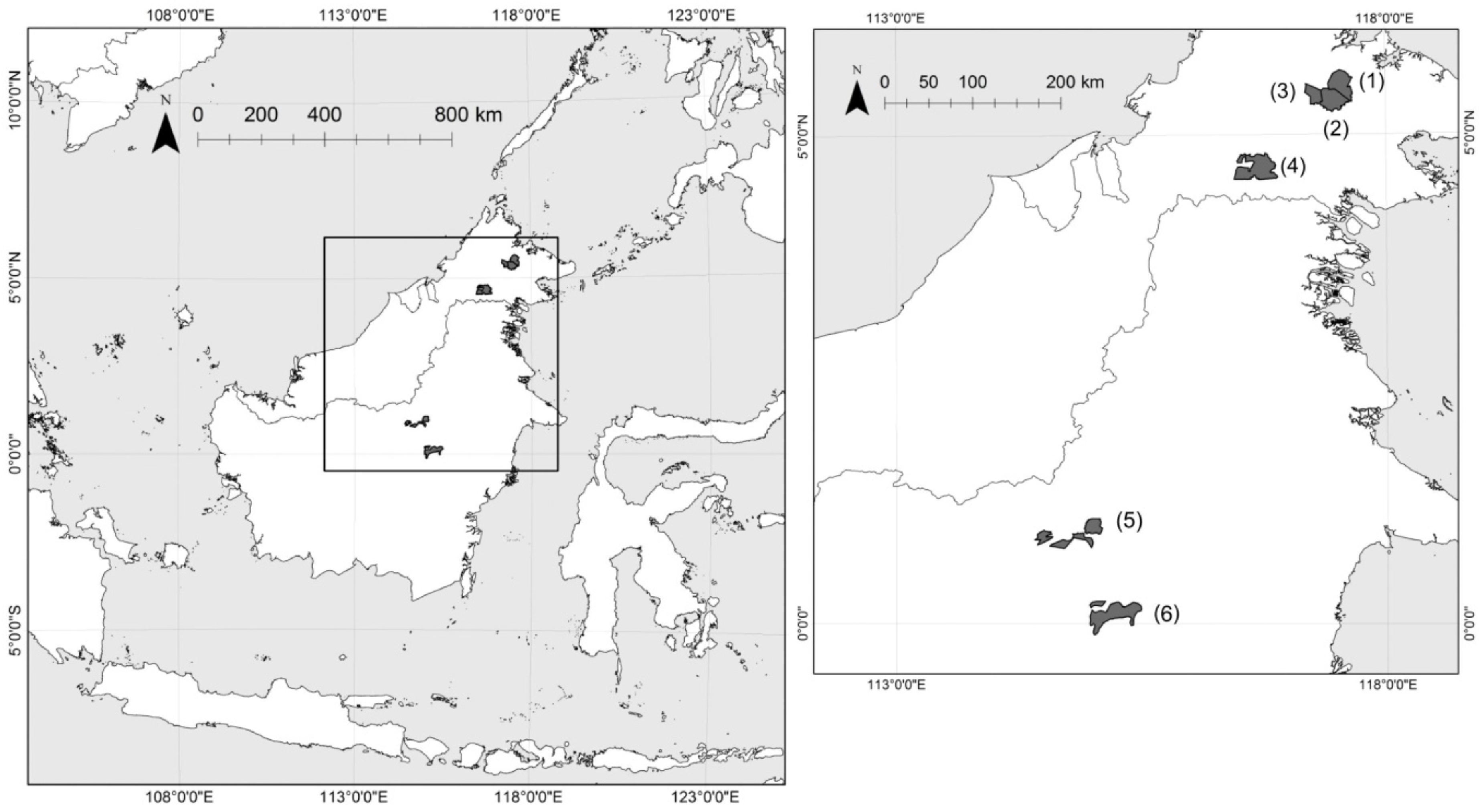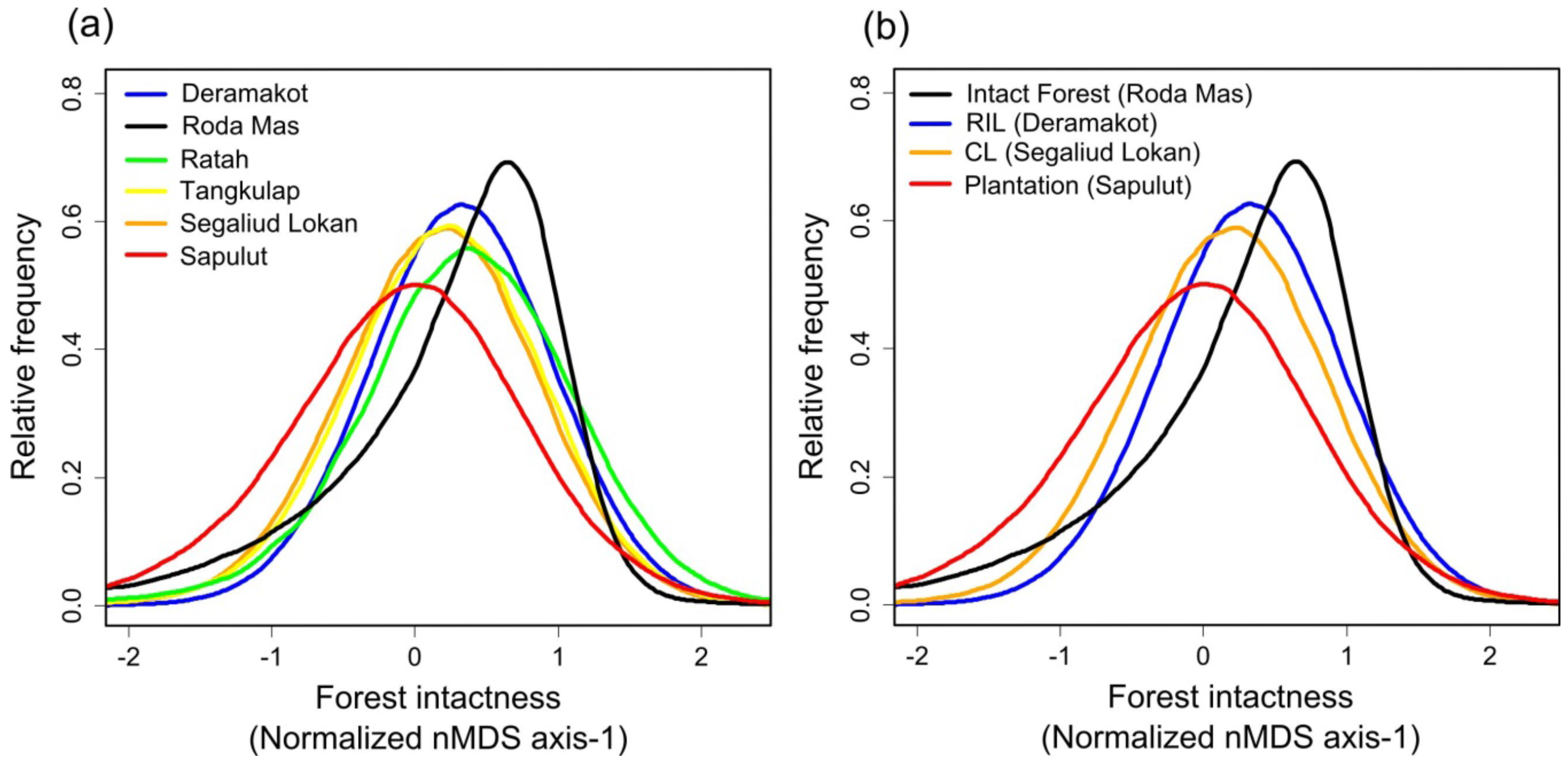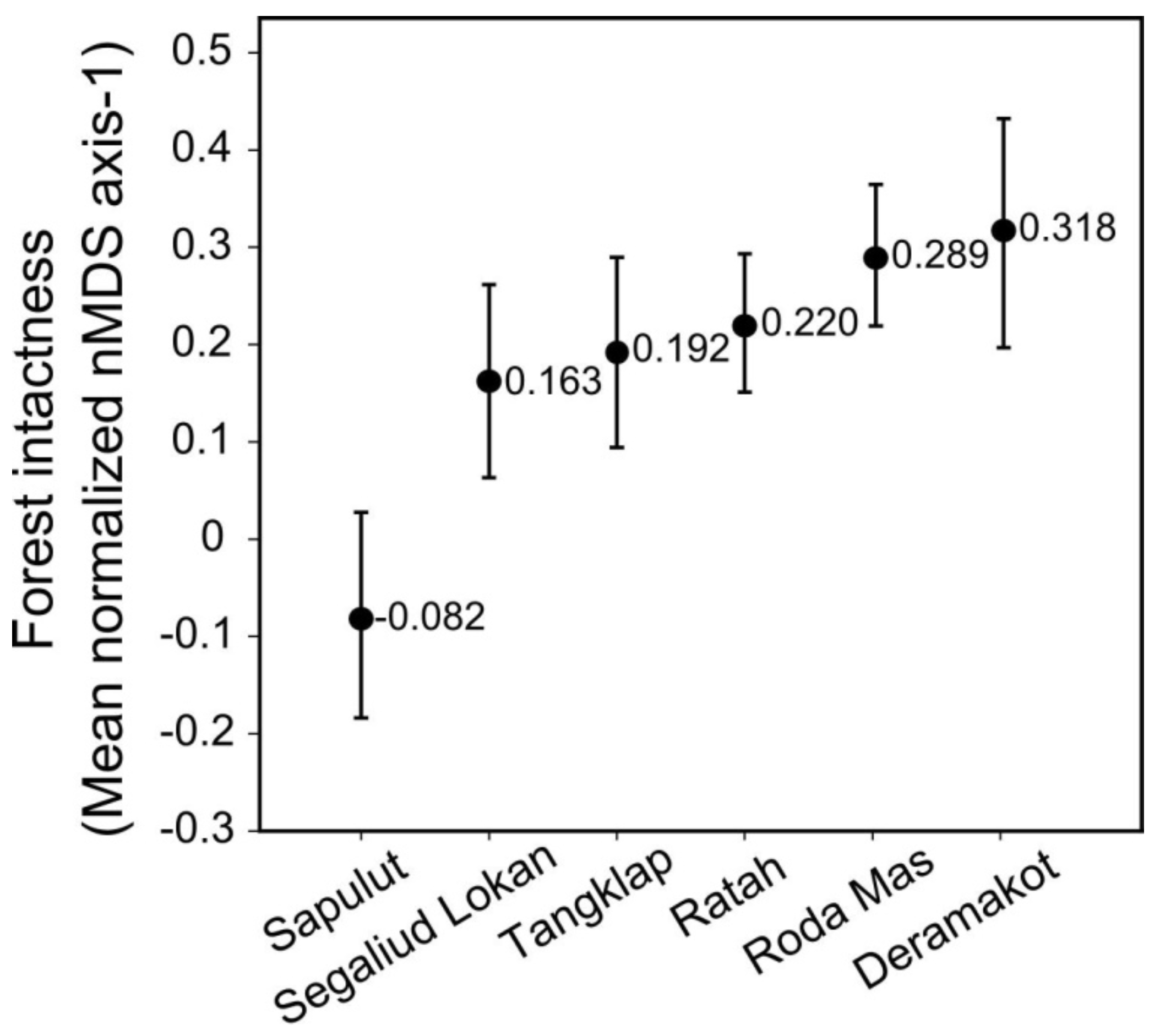Large-Scale Mapping of Tree-Community Composition as a Surrogate of Forest Degradation in Bornean Tropical Rain Forests
Abstract
:1. Introduction
2. Materials and Methods
2.1. Study Site
2.2. Field Survey
2.3. Field Data Analysis
2.4. Satellite Analysis
2.4.1. Satellite Images and Image Pre-Processing
2.4.2. Extrapolation of nMDS Axis-1 Scores Based on Landsat Data
2.5. Validation of nMDS Axis-1 Model
2.6. Comparison of Canopy Conditions Based on nMDS Axis-1 Scores among FMUs
3. Results
3.1. Forest-Intactness Maps
3.2. Validation of Community-Composition (nMDS Axis-1) Models
3.3. Comparison of Histogram/Mean nMDS Axis-1 Scores among FMUs
4. Discussion
Supplementary Materials
Acknowledgments
Author Contributions
Conflicts of Interest
References
- Hansen, M.C.; Potapov, P.V.; Moore, R.; Hancher, M.; Turubanova, S.; Tyukavina, A.; Thau, D.; Stehman, S.; Goetz, S.; Loveland, T. High-resolution global maps of 21st-century forest cover change. Science 2013, 342, 850–853. [Google Scholar] [CrossRef] [PubMed]
- CBD (Convention on Biological Diversity). CBD quick guides to the Aichi Biodiversity Targets: 2014. Available online: https://www.cbd.int/nbsap/training/quick-guides/ (accessed on 14 September 2015).
- GEO BON Office. Adequacy of Biodiversity Observation Systems to Support the CBD 2020 Targets, A Report Prepared by the Group on Earth Observations Biodiversity Observation Network (GEO BON), for the Convention on Biological Diversity; GEO BON Office: Pretoria, South Africa, 2011. [Google Scholar]
- Pereira, H.M.; Ferrier, S.; Walters, M.; Geller, G.N.; Jongman, R.; Scholes, R.J.; Bruford, M.W.; Brummitt, N.; Butchart, S.; Cardoso, A. Essential biodiversity variables. Science 2013, 339, 277–278. [Google Scholar] [CrossRef] [PubMed] [Green Version]
- Miles, L.; Kapos, V. Reducing greenhouse gas emissions from deforestation and forest degradation: Global land-use implications. Science 2008, 320, 1454–1455. [Google Scholar] [CrossRef] [PubMed]
- Paoli, G.D.; Wells, P.L.; Meijaard, E.; Struebig, M.J.; Marshall, A.J.; Obidzinski, K.; Tan, A.; Rafiastanto, A.; Yaap, B.; Slik, J.F. Biodiversity conservation in the REDD. Carbon Balance Manag. 2010, 5, 7. [Google Scholar] [CrossRef] [PubMed] [Green Version]
- CCBA. Climate, Community & Biodiversity Project Design Standards, 2nd ed.; CCBA: Arlington, VA, USA, 2008. [Google Scholar]
- Gardner, T.A.; Burgess, N.D.; Aguilar-Amuchastegui, N.; Barlow, J.; Berenguer, E.; Clements, T.; Danielsen, F.; Ferreira, J.; Foden, W.; Kapos, V. A framework for integrating biodiversity concerns into national REDD+ programmes. Biol. Conserv. 2012, 154, 61–71. [Google Scholar] [CrossRef]
- GCS. Global Conservation Standard Version 1.2; Global Conservation Standard e.V.: Offenburg, Germany, 2011. [Google Scholar]
- FSC (Forest Stewardship Council). Briefing Paper: Preliminary Outreach to FSC Membership in Preparation for the Development of FSC International Generic Indicators. 2012. Available online: http://igi.fsc.org/download.fsc-generic-indicators-outreach-briefing.28.pdf (accessed on 28 August 2015).
- Su, J.C.; Debinski, D.M.; Jakubauskas, M.E.; Kindscher, K. Beyond species richness: Community similarity as a measure of cross-taxon congruence for coarse-filter conservation. Conserv. Biol. 2004, 18, 167–173. [Google Scholar] [CrossRef]
- Imai, N.; Tanaka, A.; Samejima, H.; Sugau, J.B.; Pereira, J.T.; Titin, J.; Kurniawan, Y.; Kitayama, K. Tree community composition as an indicator in biodiversity monitoring of REDD+. Forest Ecol. Manage. 2014, 313, 169–179. [Google Scholar] [CrossRef]
- Kitayama, K. (Ed.) Co-Benefits of Sustainable Forestry: Ecological Studies of a Certified Bornean Rain Forest; Springer Science & Business Media: Tokyo, Japan, 2012.
- Sabah Forestry Department. Forest Management Plan 2: Deramakot Forest Reserve, Forest Management Unit No. 19; Sabah Forestry Department: Sandakan, Malaysia, 2005.
- Applegate, G.; Kartawinata, K.; Klassen, A. Reduced Impact Logging Guidelines for Indonesia; CIFOR: Bogor, Indonesia, 2001. [Google Scholar]
- Sabah Forestry Department. RIL Operation Guide Book, 3rd ed.Sabah Forestry Department: Sandakan, Malaysia, 2009.
- Lagan, P.; Mannan, S.; Matsubayashi, H. Sustainable use of tropical forests by reduced-impact logging in Deramakot Forest Reserve, Sabah, Malaysia. Ecol. Res. 2007, 22, 414–421. [Google Scholar] [CrossRef]
- Pinard, M.A.; Putz, F.E. Retaining forest biomass by reducing logging damage. Biotropica 1996, 28, 278–295. [Google Scholar] [CrossRef]
- Putz, F.E.; Zuidema, P.A.; Pinard, M.A.; Boot, R.G.; Sayer, J.A.; Sheil, D.; Sist, P.; Vanclay, J.K. Improved tropical forest management for carbon retention. PLoS Biol. 2008, 6, e166. [Google Scholar] [CrossRef] [PubMed] [Green Version]
- Langner, A.; Samejima, H.; Ong, R.C.; Titin, J.; Kitayama, K. Integration of carbon conservation into sustainable forest management using high resolution satellite imagery: A case study in Sabah, Malaysian Borneo. Int. J. Appl. Earth Obs. Geoinf. 2012, 18, 305–312. [Google Scholar] [CrossRef]
- Penman, J.; Gytarsky, M.; Hiraishi, T.; Krug, T.; Kruger, D.; Pipatti, R.; Buendia, L.; Miwa, K.; Ngara, T.; Tanabe, K. Definitions and Methodological Options to Inventory Emissions from Direct Human-Induced Degradation of Forests and Devegetation of Other Vegetation Types; IPCC National Greenhouse Gas Inventories Programme-Technical Support Unit: Hayama Kanagawa, Japan, 2003; p. 32. Available online: http://www.ipcc-nggip.iges.or.jp (accessed on 21 February 2016).
- Chao, A.; Chazdon, R.L.; Colwell, R.K.; Shen, T.J. A new statistical approach for assessing similarity of species composition with incidence and abundance data. Ecol. Lett. 2005, 8, 148–159. [Google Scholar] [CrossRef]
- Oksanen, J.; Blanchet, F.G.; Kindt, R.; Legendre, P.; Minchin, P.R.; O’Hara, R.; Simpson, G.L.; Solymos, P.; Stevens, M.H.H.; Wagner, H. Package ‘vegan’. Community Ecology Package, version 2.0-9. 2013.
- Kotchenova, S.Y.; Vermote, E.F.; Matarrese, R.; Klemm, F.J., Jr. Validation of a vector version of the 6S radiative transfer code for atmospheric correction of satellite data. Part I: Path radiance. Appl. Opt. 2006, 45, 6762–6774. [Google Scholar] [CrossRef] [PubMed]
- Vermote, E.F.; Tanré, D.; Deuze, J.L.; Herman, M.; Morcette, J.-J. Second simulation of the satellite signal in the solar spectrum, 6S: An overview. IEEE Trans. Geosci. Remote Sens. 1997, 35, 675–686. [Google Scholar] [CrossRef]
- Ekstrand, S. Landsat TM-based forest damage assessment: Correction for topographic effects. Photogramm. Eng. Remote Sens. 1996, 62, 151–162. [Google Scholar]
- Helmer, E.; Ruefenacht, B. Cloud-free satellite image mosaics with regression trees and histogram matching. Photogramm. Eng. Remote Sens. 2005, 71, 1079–1089. [Google Scholar] [CrossRef]
- Schott, J.R.; Salvaggio, C.; Volchok, W.J. Radiometric scene normalization using pseudoinvariant features. Remote Sens. Environ. 1988, 26, 1IN115–1416. [Google Scholar] [CrossRef]
- Vogelmann, J.E. Detection of forest change in the Green Mountains of Vermont using multispectral scanner data. Int. J. Remote Sens. 1988, 9, 1187–1200. [Google Scholar] [CrossRef]
- Hall, F.G.; Strebel, D.E.; Nickeson, J.E.; Goetz, S.J. Radiometric rectification: Toward a common radiometric response among multidate, multisensor images. Remote Sens. Environ. 1991, 35, 11–27. [Google Scholar] [CrossRef]
- Olsson, H. Regression functions for multitemporal relative calibration of Thematic Mapper data over boreal forest. Remote Sens. Environ. 1993, 46, 89–102. [Google Scholar] [CrossRef]
- Oetter, D.R.; Cohen, W.B.; Berterretche, M.; Maiersperger, T.K.; Kennedy, R.E. Land cover mapping in an agricultural setting using multiseasonal Thematic Mapper data. Remote Sens. Environ. 2001, 76, 139–155. [Google Scholar] [CrossRef]
- Song, C.; Woodcock, C.E.; Seto, K.C.; Lenney, M.P.; Macomber, S.A. Classification and change detection using Landsat TM data: When and how to correct atmospheric effects? Remote Sens. Environ. 2001, 75, 230–244. [Google Scholar] [CrossRef]
- Du, Y.; Teillet, P.M.; Cihlar, J. Radiometric normalization of multitemporal high-resolution satellite images with quality control for land cover change detection. Remote Sens. Environ. 2002, 82, 123–134. [Google Scholar] [CrossRef]
- Rouse, J.; Haas, R.; Schell, J.; Deering, D.; Harlan, J. Monitoring the Vernal Advancement and Retrogradation of Natural Vegetation; NASA/GSFC Type III Final Report; NASA/GSFC: Greenbelt, MD, USA, 1974; p. 371.
- Gao, B.-C. NDWI—A normalized difference water index for remote sensing of vegetation liquid water from space. Remote Sens. Environ. 1996, 58, 257–266. [Google Scholar] [CrossRef]
- McFeeters, S.K. The use of the Normalized Difference Water Index (NDWI) in the delineation of open water features. Int. J. Remote Sens. 1996, 17, 1425–1432. [Google Scholar] [CrossRef]
- Takeuchi, W.; Yasuoka, Y. Development of normalized vegetation, soil and water indices derived from satellite remote sensing data. J. Jpn Soc. Photogramm. Remote Sens. 2004, 43, 7–19. [Google Scholar] [CrossRef]
- Huete, A.; Didan, K.; Miura, T.; Rodriguez, E.P.; Gao, X.; Ferreira, L.G. Overview of the radiometric and biophysical performance of the MODIS vegetation indices. Remote Sens. Environ. 2002, 83, 195–213. [Google Scholar] [CrossRef]
- Haralick, R.M. Statistical image texture analysis. In Handbook of Pattern Recognition and Image Processing; Young, T.Y., Fu, K.S., Eds.; Academic Press: Orlando, FL, USA, 1986; Volume 86, pp. 247–279. [Google Scholar]
- Baatz, M.; Benz, U.; Dehghani, S.; Heynen, M.; Höltje, A.; Hofmann, P.; Lingenfelder, I.; Mimler, M.; Sohlbach, M.; Weber, M. eCognition Professional User Guide 4; Definiens Imaging: Munich, Germany, 2004. [Google Scholar]
- Kitayama, K. An altitudinal transect study of the vegetation on Mount Kinabalu, Borneo. Vegetatio 1992, 102, 149–171. [Google Scholar] [CrossRef]
- Aiba, S.-I.; Kitayama, K. Structure, composition and species diversity in an altitude-substrate matrix of rain forest tree communities on Mount Kinabalu, Borneo. Plant Ecology 1999, 140, 139–157. [Google Scholar] [CrossRef]
- Roff, D.A. Introduction to Computer-Intensive Methods of Data Analysis in Biology; Cambridge University Press: Cambridge, UK; New York, NY, USA, 2006. [Google Scholar]
- Schmidtlein, S.; Sassin, J. Mapping of continuous floristic gradients in grasslands using hyperspectral imagery. Remote Sens. Environ. 2004, 92, 126–138. [Google Scholar] [CrossRef]
- Schmidtlein, S.; Zimmermann, P.; Schüpferling, R.; Weiss, C. Mapping the floristic continuum: Ordination space position estimated from imaging spectroscopy. J. Veg. Sci. 2007, 18, 131–140. [Google Scholar] [CrossRef]
- Feilhauer, H.; Schmidtlein, S. Mapping continuous fields of forest alpha and beta diversity. Appl. Veg. Sci. 2009, 12, 429–439. [Google Scholar] [CrossRef]
- Feilhauer, H.; Faude, U.; Schmidtlein, S. Combining Isomap ordination and imaging spectroscopy to map continuous floristic gradients in a heterogeneous landscape. Remote Sens. Environ. 2011, 115, 2513–2524. [Google Scholar] [CrossRef]
- Gu, H.; Singh, A.; Townsend, P.A. Detection of gradients of forest composition in an urban area using imaging spectroscopy. Remote Sens. Environ. 2015, 167, 168–180. [Google Scholar] [CrossRef]
- Asner, G.P.; Martin, R.E. Airborne spectranomics: Mapping canopy chemical and taxonomic diversity in tropical forests. Front. Ecol. Environ. 2009, 7, 269–276. [Google Scholar] [CrossRef]
- Rocchini, D. Effects of spatial and spectral resolution in estimating ecosystem α-diversity by satellite imagery. Remote Sens. Environ. 2007, 111, 423–434. [Google Scholar] [CrossRef]
- Wittmann, F.; Anhuf, D.; Funk, W.J. Tree species distribution and community structure of central Amazonian várzea forests by remote-sensing techniques. J. Trop. Ecol. 2002, 18, 805–820. [Google Scholar] [CrossRef]
- Tangki, H.; Chappell, N.A. Biomass variation across selectively logged forest within a 225-km2 region of Borneo and its prediction by Landsat TM. For. Ecol. Manag. 2008, 256, 1960–1970. [Google Scholar] [CrossRef]
- Steininger, M. Satellite estimation of tropical secondary forest above-ground biomass: Data from Brazil and Bolivia. Int. J. Remote Sens. 2000, 21, 1139–1157. [Google Scholar] [CrossRef]
- Rocchini, D.; Balkenhol, N.; Carter, G.A.; Foody, G.M.; Gillespie, T.W.; He, K.S.; Kark, S.; Levin, N.; Lucas, K.; Luoto, M. Remotely sensed spectral heterogeneity as a proxy of species diversity: Recent advances and open challenges. Ecol. Inform. 2010, 5, 318–329. [Google Scholar] [CrossRef]
- Slik, J.; Poulsen, A.; Ashton, P.; Cannon, C.; Eichhorn, K.; Kartawinata, K.; Lanniari, I.; Nagamasu, H.; Nakagawa, M.; Van Nieuwstadt, M. A floristic analysis of the lowland dipterocarp forests of Borneo. J. Biogeogr. 2003, 30, 1517–1531. [Google Scholar] [CrossRef]





| Name of FMU | State/Province, Nation | Silviculture and Timber Harvest | Forest Certification | Established Plot Number |
|---|---|---|---|---|
| Segaliud Lokan | Sabah, Malaysia | 1958–2002 CL, Since 2003 RIL | MTCC | 50 |
| Deramakot | 1956–1985 CL, Since 1995 RIL | FSC | ||
| Tangkulap | 1970–2002 CL | FSC | ||
| Sapulut | 1956–2000 CL, Since 2001 RIL | MTCC | 50 | |
| Roda Mas | East Kalimantan, Indonesia | Since at least 2008 RIL | FSC | 50 |
| Ratah | 1972–2010 CL, Since 2011 RIL | FSC | 90 |
| R2 | Coefficient | SE | T-value | Pr (>|t|) | |
|---|---|---|---|---|---|
| SegaliudLokan-Deramakot-Tangkulap (N = 47) | |||||
| B7TM | 0.642 | −0.38989 | 2.80E-04 | 3.69863 | <0.001 |
| GLCM_mean_NDVI | −0.25902 | 1.20E-02 | 2.23543 | 3.10E-02 | |
| GLCM_correlation_B3TM | −0.32586 | 3.80E-01 | 3.3816 | 1.60E-03 | |
| GLCM_mean_B1TM | 0.30875 | 9.40E-03 | 2.76426 | 8.50E-03 | |
| GLCM_homogenity_B4TM | 0.1891 | 3.70E+00 | 2.03608 | 4.80E-02 | |
| Sapulut (N = 45) | |||||
| B6OLI | 0.604 | −0.46159 | 2.40E-05 | 3.7795 | <0.001 |
| GLCM_contrast_B3OLI | 0.37483 | 3.10E-05 | 3.8679 | <0.001 | |
| B5OLI | −0.36385 | 1.20E-05 | 3.0253 | 4.30E-03 | |
| GLCM_mean_B6OLI | −0.286 | 8.20E-03 | 2.8178 | 7.50E-03 | |
| Roda Mas (N = 45) | |||||
| B6OLI | 0.745 | −0.86698 | 7.50E-05 | 4.9699 | <0.001 |
| SD_NDSI | −0.75056 | 1.20E-04 | 4.5416 | <0.001 | |
| SD_NDWI | −2.12925 | 2.20E-04 | 4.6781 | <0.001 | |
| SD_NDVI | 2.00116 | 4.50E-04 | 3.373 | 1.70E-03 | |
| B4OLI | 0.56146 | 4.70E-04 | 2.3481 | 2.40E-02 | |
| Ratah (N = 64) | |||||
| B7TM | 0.615 | −1.42357 | 1.30E-03 | 7.02905 | <0.001 |
| B3TM | 0.75859 | 2.80E-03 | 3.74366 | <0.001 | |
| GLCM_dissimilarity_B4TM | 0.25656 | 9.80E-03 | 3.2506 | 1.90E-03 | |
© 2016 by the authors; licensee MDPI, Basel, Switzerland. This article is an open access article distributed under the terms and conditions of the Creative Commons Attribution (CC-BY) license (http://creativecommons.org/licenses/by/4.0/).
Share and Cite
Fujiki, S.; Aoyagi, R.; Tanaka, A.; Imai, N.; Kusma, A.D.; Kurniawan, Y.; Lee, Y.F.; Sugau, J.B.; Pereira, J.T.; Samejima, H.; et al. Large-Scale Mapping of Tree-Community Composition as a Surrogate of Forest Degradation in Bornean Tropical Rain Forests. Land 2016, 5, 45. https://doi.org/10.3390/land5040045
Fujiki S, Aoyagi R, Tanaka A, Imai N, Kusma AD, Kurniawan Y, Lee YF, Sugau JB, Pereira JT, Samejima H, et al. Large-Scale Mapping of Tree-Community Composition as a Surrogate of Forest Degradation in Bornean Tropical Rain Forests. Land. 2016; 5(4):45. https://doi.org/10.3390/land5040045
Chicago/Turabian StyleFujiki, Shogoro, Ryota Aoyagi, Atsushi Tanaka, Nobuo Imai, Arif Data Kusma, Yuyun Kurniawan, Ying Fah Lee, John Baptist Sugau, Joan T. Pereira, Hiromitsu Samejima, and et al. 2016. "Large-Scale Mapping of Tree-Community Composition as a Surrogate of Forest Degradation in Bornean Tropical Rain Forests" Land 5, no. 4: 45. https://doi.org/10.3390/land5040045






